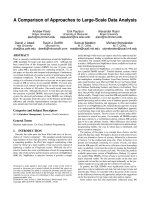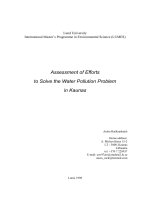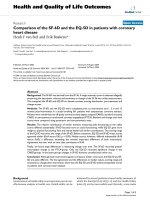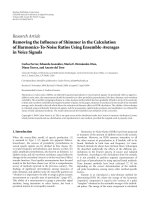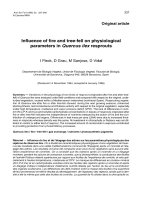Comparison Of Batch To Batch Shade Variation Considering Parameters in Knit Dyeing
Bạn đang xem bản rút gọn của tài liệu. Xem và tải ngay bản đầy đủ của tài liệu tại đây (637.92 KB, 19 trang )
Department of Textile Engineering
Project Title :
Comparison of Batch to Batch Shade Variation Considering
Parameters in Knit Dyeing
SOUTHEAST UNIVERSITY
!"#
$% &'% () *(+
*, * /+01#
*(2220)34**505*($0
. 6%+7 (*-
$% 8)34* ( % (
''9
©right
Shade is the depth of color percentage. Shade is expressed in percentage of
dye amount in unit weight of fabric. Shade matching depends on the accuracy
of the man's eye. It is a visual process for this reason same shade may have
difference comments from different person.
Shade:
It is the variation of shade or depth of color (hue) in same fabric roll or among
different batches. In dyed fabric often shade variation is found. Shade variation
may occur selvage to selvage, selvage to center of fabric width or one end of
the fabric rolls to another end.
Shading or shade variation is considered as one big problem in fabric. A lot of
orders are cancelled because of the shade variation between the batches.
Though there is a tolerance is given or set , but it is too tough to maintain the
exact same shade among all the batches. And here is the success of a Textile
Engineer.
Shade Variation
In the area of textiles, the most widely employed method of applying colors is
dyeing. Although dyeing process affected by many inside and outside
parameters, it is a mature technology during several thousand years. Dyeing is
still complicated today to fully understand and control dyeing which is more an
art than a science. Besides, it is difficult to monitor but must be dealt with to
obtain quality products by control various parameter.
Controlling Parameters in Knit Dyeing
1Machine parameters:
Temperature
Time
Pressure
Speed (r.p.m)
Stability of machine
Dosing
Liquor ratio
Rinsing
Controlling Parameters of Dyeing Process are
mentioned bellow:
Process parameters:
pH
Pressure
Time
Temperature
Liquor ratio
Water Hardness
Recipe
Fastness
Chemical parameters:
Strength
Purity
Chemical composition
Country of origin
Environment
1
Material parameters:
Maturity of fiber
Count Variation
Foreign material
Yarn uniformity
Weave Plan
Fabrics faults
Batch to Batch Shade variation
Dyeing is one of the sophisticated part of the textile production. There are
so many reasons behind the batch to batch shade variation. They are
given below:
Preparation Stage:
Excessive Heat setting: Heat-setting has effect on dye bond
formation on synthetic fiber. Uneven and excessive heat setting can
cause shade variation.
Uneven pretreatment: Uneven, improper scouring & bleaching
causes shade variation.
Causes of Batch to Batch shade variation in dyeing
Using Chemicals of different concentration: If concentration of input
chemical is varied from one batch to another then shade variation is occurred.
Improper color dosing: Improper color dosing can cause shade variation.
Workers’ Negligence: Due to worker’s negligence, shade variation
happens.
On process Causes :
Rope length & Cycle time: If rope length is same but cycle
time is varied from one batch to another it may cause shade
variation. For example, if cycle time of first batch is greater
than the second batch results each portion of the loop will not
get same time for exhaustion and fixation of dyestuff. So the
dye penetration percentage becomes higher for first batch.
Reel speed: Reel speed changes with fabric GSM, loads per
nozzle, cycle time etc. which has great effect on shade
variation.
Lack of control on dyeing m/c
Running time: Running time is another factor for batch to batch shade
variation. Due to the variation of running time of different stage of dyeing, the
action of same chemical/dyes, used in different batches also varied from one
batch to another batch. This also may cause batch to batch shade variation.
Fluctuation in power & temperature: Fluctuation in power supply and
temperature also responsible for variation.
Dyes lot variation: Dyes strength, reactivity etc. properties can vary lot to lot
even drum to drum that causes shade variation.
P
H
: Throughout overall dyeing process, pH has great impact on shade
variation. In reactive dyeing, fixation pH is very much important to achieve
uniform shade. Every dyestuff appears in different tone under different pH
conditions. It has observed that, if pH of polyester dyeing is not within the
range, shade will become yellowish, dull etc.
Improper neutralization: If neutralization is not done properly, residual
alkali can affect dyeing as well as leads to shade variation.
Soaping: According to the depth of shade; amount of soap, soaping time and
temperature can change shade and can make shade variation.
Final cationic fixing operation: Fixation operation can cause shade
variation in case of time, depth of shade.
Poor Lab-to-bulk Correlation: If in bulk production same liquor ratio,
recipe, chemicals, process stages, runtime etc is not followed according to lab,
there is much more opportunities to acquire shade variation as well as other
process faults.
Finishing Stage:
Not only the preparation and dyeing operations are important, final finishing
operation also is very important to avoid batch-to-batch variation.
Softener quality: according to difference in softener quality, strength,
nature, concentration, pH etc. shade variation can be noticed during finishing.
Unequal drying temperature: If drying temperature is not equal, shade
variation happens.
Follow the standard pretreatment procedure.
Standard dyes and chemicals need to be used.
Maintain the same liquor ratio
Try to maintain equal loop length, equal amount of material per nozzle.
Maintain the same dyeing cycle.
Maintain equal dosing time, runtime
Identical dyeing procedure should be followed for the same depth of the
Shade.
Remedies
Make sure that the operators add the right bulk chemicals at the same time
and temperature in the process.
Dyes and chemicals strength should be checked regularly.
The pH, hardness and sodium carbonate content of supply water should check
daily.
Lab to bulk correlation should be maintained properly.
Equal finishing parameters (drying temperature, softener treatment, squeezing
pressure etc.) should be maintained properly.
Remedies

